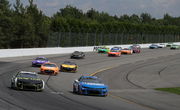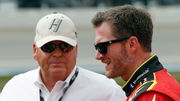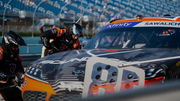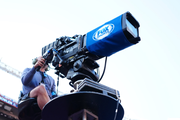
via Imago
NASCAR, Motorsport, USA NASCAR All-Star Race May 21, 2023 North Wilkesboro, North Carolina, USA Team Owner Richard Childress watches from atop Victory Lane during the All Star Race at North Wilkesboro Speedway. North Wilkesboro North Wilkesboro Speedway North Carolina USA, EDITORIAL USE ONLY PUBLICATIONxINxGERxSUIxAUTxONLY Copyright: xJimxDedmonx 20230521_ams_db2_162 Image Credits – Imago

via Imago
NASCAR, Motorsport, USA NASCAR All-Star Race May 21, 2023 North Wilkesboro, North Carolina, USA Team Owner Richard Childress watches from atop Victory Lane during the All Star Race at North Wilkesboro Speedway. North Wilkesboro North Wilkesboro Speedway North Carolina USA, EDITORIAL USE ONLY PUBLICATIONxINxGERxSUIxAUTxONLY Copyright: xJimxDedmonx 20230521_ams_db2_162 Image Credits – Imago
Jesse Love had every reason to smile on Saturday night. Under the lights at Rockingham Speedway, he muscled his No. 2 Richard Childress Racing Chevrolet through 14 cautions, two red flags, and a wild overtime finish to cross the line first. Fans roared. The track had returned to the Xfinity Series calendar after more than 20 years, and Love was the one who etched his name in history.
The 20-year-old California native, already seen by many as RCR’s rising star, slid out the roof hatch, pumped his fists to the cheering crowd, and made a heartfelt victory speech. “What an incredible race track. You probably can’t even hear me right now… This race track is right up my alley. It’s hammer down,” he said, nearly shouting over the roaring fans. He dedicated the moment to his girlfriend’s sister Jessica, who died a year ago from skin cancer, and urged fans to get checked. The moment felt emotional, raw, and real.
But minutes later, NASCAR cut the celebration short. Officials found a rear suspension violation during post-race inspection and disqualified Love’s car. They stripped him of the win and dropped him to 37th. Suddenly, Richard Childress’ rising star stood on the sidelines, watching someone else take the trophy. And now, as we wait for an appeal, many fans and insiders are asking: Did NASCAR rob Jesse Love of a rightful victory?
ADVERTISEMENT
Article continues below this ad
The rear suspension controversy: What happened and why it matters?
Here’s what we know. NASCAR disqualified the No. 2 car for breaking rule 14.14.2.i-5.h. That’s a regulation most fans have never heard of, but it played a huge role in taking away a win. It centers around the mating surfaces between the truck’s trailing arm and the U-bolt saddle on the car’s rear suspension. The rule says these parts must be in complete contact with each other at all times.
That might sound like a small detail, but it’s not. The rear axle housing connects to the truck arm through a U-bolt. If there’s even a gap of more than 0.010 inches, it’s considered illegal. NASCAR checks that measurement in a post-race teardown. So why does this matter? Because a slight separation can allow for more flex in the rear suspension. That kind of flex can improve performance, especially in how the car handles cornering and loads.
Some believe Love’s team might’ve under-torqued the U-bolt intentionally to gain that slight flex—an edge that can make a car more stable, more efficient, and just plain faster. NASCAR, however, draws a hard line. Parts have to be tight and in alignment as mentioned in the rule book—no wiggle room. Xfinity Series director Eric Peterson made the ruling clear. “They need to be tight and touching each other the whole time. Unfortunately, that was not the case,” he said.
The No. 2 car was disqualified for a rule that states that:
"All mating surfaces between the truck trailing arm and the U-bolt saddle must be in complete contact with each other."
The mating surfaces are ciricled in red here. Let's take a closer look. https://t.co/wPRqV7K753 pic.twitter.com/XDsYH5SFd4
— Bozi Tatarevic (@BoziTatarevic) April 20, 2025
Now, there’s always a chance something moved during the race—Rockingham was rough, chaotic, and full of contact. A part may have shifted. That’s why Richard Childress Racing is expected to appeal. If they believe it was unintentional or due to damage, they’ll argue their case. But for now, Love’s win is wiped off the books. However, the consequences were massive. Sammy Smith, who finished second, was bumped up to first,
The JR Motorsports driver also claimed the final $100,000 Dash 4 Cash bonus. Even Smith admitted he was second best to Love’s #2 car, “The 2 car ultimately had the best car. Those guys did a good job.” He got the trophy, but he knew who was the fastest. For now, Love was left with nothing. From a career-best moment to a technicality-induced collapse, it was a brutal swing. The question remains—was it intentional setup tweaking, or just bad luck in a brutal race? NASCAR’s rulebook doesn’t care about intent. It cares about precision.
Trending
ADVERTISEMENT
Article continues below this ad
Why is NASCAR under fire? The Parker Kligerman parallel
Jesse Love’s heartbreak isn’t the first time NASCAR has taken a win away in 2025. Just weeks earlier, Parker Kligerman found himself in the same situation. Kligerman, a part-time Truck Series driver and full-time Cup and Xfinity broadcaster, won the Daytona season opener. He called it the “biggest win of my entire life.” Fans cheered, he celebrated in the infield grass, and the moment was pure bliss for the driver and his team.
Then came post-race inspection. Officials found Kligerman’s truck too low in the rear on both sides. Henderson Motorsports appealed, but the panel upheld the penalty. NASCAR stripped the win and declared Corey Heim the new victor. Just like Jesse Love, Kligerman went from first to forgotten in a matter of hours. There are parallels between the two situations. Both drivers crossed the finish line first and gave emotional speeches.
Both had cars that may have bent the rule a little too much, potentially due to racing conditions or setup gambles. And in both cases, NASCAR stood firm. The key difference? The nature of the violations. Kligerman’s issue was with overall ride height—something that can vary due to wear, damage, or contact.
ADVERTISEMENT
Article continues below this ad
Jesse Love’s problem was far more technical—about part-to-part contact within a suspension assembly that affects chassis flex. Still, the result was the same. A win-lose. A story rewritten. For fans, it’s a tough pill to swallow. Many question why NASCAR conducts post-race inspection and demand to abolish this rule. It certainly takes away the moment from the drivers and the team celebrating in the victory lane.
ADVERTISEMENT
ADVERTISEMENT
ADVERTISEMENT
ADVERTISEMENT






